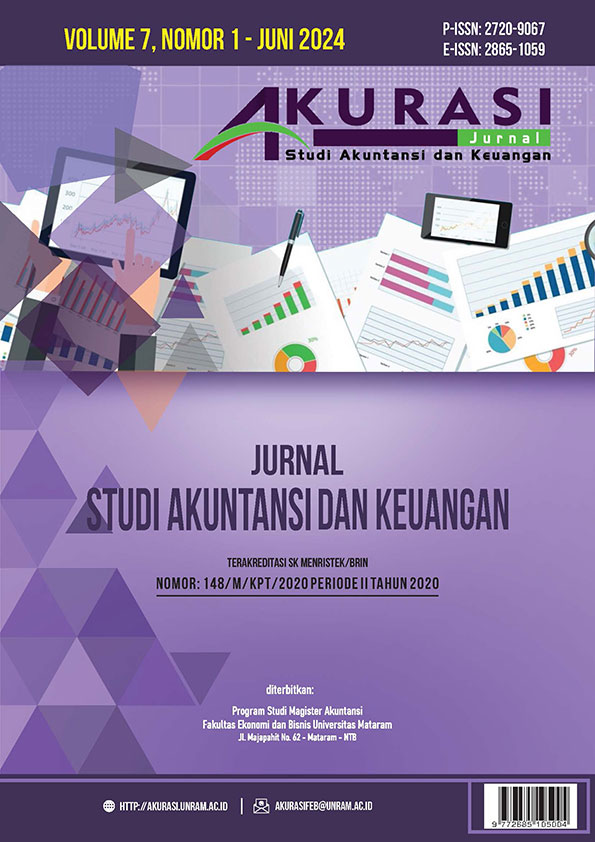KEMAMPUAN ARTIFICIAL INTELLIGENCE TERHADAP PENDETEKSIAN FRAUD: STUDI LITERATUR
DOI:
https://doi.org/10.29303/akurasi.v7i1.488Keywords:
Artificial Intelligence, Financial Fraud, Audit, Audit Methdology, Digitalization EraAbstract
This research aims to determine the role of artificial intelligence in detecting financial fraud in audits. The study was conducted by collecting 16 articles from reputable journals published between 2018-2024, which will be classified based on the methods used and the research results. The method used in this research is Systematic Literature Review (SLR), which is used to examine the results, methodologies, topics/themes, recommendations, and limitations of the published articles. The analysis results provide evidence that Artificial Intelligence (AI) has a positive impact on detecting financial fraud in audits. The forms of AI that have been implemented in companies are Artificial Neural Network (ANN) and Machine Learning. ANN is a model of a neural system inspired by human thinking processes. The use of ANN in detecting financial fraud can make a significant contribution to fraud prevention and detection efforts. Machine Learning is a technology capable of recognizing unusual patterns or anomalies that may indicate the possibility of fraud or manipulation in financial reports. Despite its potential benefits, the implementation of AI in audits is not without challenges. Privacy issues, data security, and ethical considerations surrounding the use of sensitive information are important factors that need to be addressed. Digital transformation involves not only technological influences but also changes in culture, operations, and business models
Downloads
References
Abdullah, A. A. H., & Almaqtari, F. A. (2024). The impact of artificial intelligence and industry 4.0 on transforming accounting and auditing practices. Journal of Open Innovation: Technology, Market, and Complexity, 10(1), 1–20. https://doi.org/10.1016/j.joitmc.2024.100218
Agustina, S., & Wandansari, R. P. (2023). Seberapa efektifkah artificial intelligence dalam fraud detection pada masa COVID-19: Systematic Literature Review. Jurnal Aplikasi Akuntansi, 8(1), 118–130. https://doi.org/10.29303/jaa.v8i1.254
Ajzen, I., & Martin Fishbein. (1980). Understanding Attitudes and Predicting Social Behavior. Prentice Hall.
Akmaluddin, M., & Dewayanto, T. (2023). Systematic literature review: Implementasi artificial intelligence dan machine learning pada bidang akuntansi manajemen. Diponegoro Journal Of Accounting, 12(4), 1–11.
Arens, A. A., Elder, R. J., Beasley, M. S., & Hogan, C. E. (2017). Auditing and Assurance Services An Integrated Approach Sixteenth Edition. Pearson Education Limited.
Columbus, L. (2019, July 1). AI is Predicting The Future of Online Fraud Detection. Forebes. Diakses pada tanggal 17 Februari 2024. https://www.forbes.com/sites/louiscolumbus/2019/08/01/ai-is-predicting-the-future-of-online-fraud-detection/?sh=42b63ca874f5
Cressey, D. R. (1953). Other People’s Money: A Study in The Social Psychology of Embezzlement. Free Press.
Davis, F. (1986). A Technology Acceptance Model for Empirically Testing New End User Information Systems: Theory and Result [Unpublished Ph.D Disertation]. Sloan School of Management, Massachusetts Institut of Technology (MIT).
Fedyk, A., Hodson, J., Khimich, N., & Fedyk, T. (2022). Is artificial intelligence improving the audit process? Review of Accounting Studies, 27, 938–985. https://doi.org/10.1007/s11142-022-09697-x
Handoko, B. L., & Soepriyanto, G. (2018). Merunut Kasus SNP Finance & Auditor Deloitte Indonesia (1). Accounting Binus.
Hidayatullah. (2023).Perkembangan Teknologi Arificial Intelligence (AI) dan Audit. Salemba Empat.
Korol, V., Dmytryk, O., Karpenko, O., Riadinska, V., Basiuk, O., Kobylnik, D., Moroz, V., Safronova, O., Alisov, E., & Mishchenko, T. (2022). Elaboration of recommendations on the development of the state internal audit system when applying the digital technologies. Eastern-European Journal of Enterprise Technologies,1(13-115),39–48.
Kumar, G., Muckley, C. B., Pham, L., & Ryan, D. (2018). Can alert models for fraud protect the elderly clients of a financial institution? Financial Economic Network Electronic Paper Collection, 1–26. https://doi.org/10.1080/1351847X.2018.1552603
Lame, G. (2019). Systematic literature reviews: An introduction. Proceedings of the Design Society: International Conference on Engineering Design, 1(1), 1633–1642. https://doi.org/10.1017/dsi.2019.169
Malali, A. B., & Gopalakrishnan, S. (2020). Application of artificial intelligence and its powered technologies in the Indian banking and financial industry: An Overview. IOSR Journal of Humanities and Social Science, 25(4), 55–60. https://doi.org/10.9790/0837-2504065560
Mohanty, B., Aashima, & Mishra, S. (2023). Role of artificial intelligence in financial fraud detection. Academy of Marketing Studies Journal, 27(4), 1–15.
Muawanah, A., Adawiyah, D., Maisarah, I., Rafli, A. A. M., & Widiastuti, N. P. E. (2022). Perilaku auditor menyikapi munculnya artificial intelligence dalam proses audit. Jurnal Publikasi Ekonomi dan Akuntansi, 2(1), 52–60. https://doi.org/https://doi.org/10.51903/jupea.v2i1.152
Rachmawati, A. M., Noviandari, T., Septian, M. R. E., & Ratnawati, T. (2023). Studi literatur kecerdasan buatan untuk audit: Kolaborasi atau ancaman bagi profesi auditor? JURA: Jurnal Riset Akuntansi, 1(3), 75–82. https://doi.org/10.54066/jura-itb.v1i3.396
Rumahorbo, H. H., & Dewayanto, T. (2023). Pengaruh transformasi digital: Kecerdasan buatan dan internet of things terhadap peran dan praktik audit internal: Systematic Literature Review. Diponegoro Journal of Accounting, 12(4), 1–15. http://ejournal-s1.undip.ac.id/index.php/accounting
Sadgali, I., Sael, N., & Benabbou, F. (2019). Performance of machine learning techniques in the detection of financial frauds. Procedia Computer Science, 148, 45–54. https://doi.org/10.1016/j.procs.2019.01.007
Seethamraju, R. C., & Hecimovic, A. (2020). Impact of artificial intelligence on auditing - An exploratory study. Americas Conference on Information Systems, 1–10. https://doi.org/10.1177/03128962221108440
Septiriana, R., Rheno Widianto, S., & Darma, P. E. (2024). Application of artificial intelligence in the prevention of fraud in financial statements. Jurnal Ekonomi, 13. https://doi.org/10.54209/ekonomi.v13i01
Siladjaja, M., Anwar, Y., & Djan, I. (2022). The impact of real manipulation and tax management on future market value: An artificial intelligence simulation of high earnings quality. ACRN Journal of Finance and Risk Perspectives, 11(1), 33–54. https://doi.org/10.35944/jofrp.2022.11.1.003
Soeprajitno, R. R. W. N. (2019). Potensi artificial intelligence (AI) menerbitkan opini audit? Jurnal Riset Akuntansi Dan Bisnis Airlangga, 4(1), 560–573. https://doi.org/10.31093/jraba.v4i1.142
Sood, P., Sharma, C., Nijjer, S., & Sakhuja, S. (2023). Review the role of artificial intelligence in detecting and preventing financial fraud using natural language Processing. International Journal of System Assurance Engineering and Management, 14(6), 2120–2135. https://doi.org/10.1007/s13198-023-02043-7
Yadiati, W., Rezwiandhari, A., & Ramdany. (2023). Detecting fraudulent financial reporting in state-owned company: Hexagon theory approach. Jurnal Akuntansi: Kajian Ilmiah Akuntansi, 10(1), 128–147. https://doi.org/10.30656/jak.v10i1.5676
Zemánková, A. (2019). Artificial intelligence and blockchain in audit and accounting: Literature review. Wseas Transactions on Business and Economics, 16, 568–581.
Zhou, Y., Li, H., Xiao, Z., & Qiu, J. (2023). A User-centered explainable artificial intelligence approach for financial fraud detection. Finance Research Letters, 58, 1–10. https://doi.org/10.1016/j.frl.2023.104309
Downloads
Published
How to Cite
Issue
Section
License
Authors who publish in Akurasi: Jurnal Studi Akuntansi dan Keuangan agree to the following terms:
- Authors retain the copyright of their articles.
- Authors grant Akurasi: Jurnal Studi Akuntansi dan Keuangan the right of first publication.
- Articles are licensed under the Creative Commons Attribution-ShareAlike 4.0 International License (CC BY-SA 4.0).
- This license allows anyone to copy, distribute, display, and adapt the articles for any purpose, including commercial use, as long as proper credit is given to the author(s) and the source, and derivative works are distributed under the same license.
- All published articles are open access and may be used for educational, research, and scientific purposes.
License: 
This work is licensed under a Creative Commons Attribution-ShareAlike 4.0 International License.







